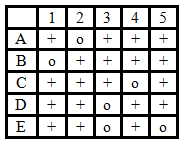As light hits the retina in a human it must pass through this sequence of cells:
A. rod and cone cells, bipolar cells, ganglion
cells, pigmented epithelium.
B. bipolar cells, ganglion cells, pigmented
epithelium, rod and cone cells.
C. ganglion cells, rod and cone cells, bipolar
cells, pigmented epithelium.
D. ganglion cells, bipolar cells, rod and cone
cells, pigmented epithelium.
D
You might also like to view...
Match the following bones to their location in the body.
Bone Location radius a. pectoral girdle coxal bone b. leg ribs c. axial skeleton scapula d. arm fibula e. pelvic girdle
A new flower species has a unique photosynthetic pigment. The leaves of this plant appear to be blue-green. What wavelengths of visible light does this pigment reflect?
A. green, red, and violet B. green and blue C. red, yellow, and green D. blue and violet E. red and yellow
Indicate the order of the point mutations in the rII region.
Shown below are the maps of a series of rII- deletion strains (1–5). The deleted region is indicated as (......) and the intact region as ______.
1 ___________(...........)_______________
2 _________________(...........)_________
3 (.....................)_____________________
4 ________________________(................)
5 _____(..........)______________________
rII- phage strains A-E have point mutations in the rII region. E.coli K(?) cells are coinfected with one phage that has a deletion and one phage that has a point mutation. The presence of wild-type progeny phage is assessed by the presence (+) or absence (o) of plaques.

A) CADBE
B) DEBAC
C) BADCE
D) ABDEC
E) CEADB
This seed structure's purpose is to nourish the
young plant until its leaves can begin photosynthesis.
a. plumule b. hypocotyl c. radicle d. cotyledon e. coleoptile